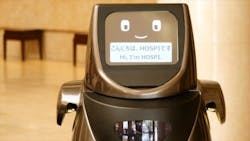Service robots from Panasonic deployed into an airport and hotel in Japan
Having already been deployed into hospitals for drug and specimen delivery purpose, Panasonic Corporation’s HOSPI(R) autonomous service robots were deployed in the Narita International Airport and the ANA Crowne Plaza Narita for testing.
HOSPI(R) is a vision-guided robot that uses preprogrammed map information and using camerasand advanced collision-avoidance algorithms to deliver goods autonomously, without colliding into people or objects in its route. HOSPI(R), assuming its specifications are similar to this model, weights approximately 352 lbs. with battery, can operate for up to 9 hours, and can carry up to about 44 lbs.
In order to navigate autonomously, the robot features two functions, called Omni-View and human detection with classification, according to Panasonic. Omni-View is synthesized from images captured by four CY-RC70KD Panasonic car cameras mounted on the robot. Images are transmitted wirelessly to a user’s PC and mapped onto a 3D model constructed from four overlapping quarters of a hemisphere, via a mapping table that is pre-generated through calibration. Blending is applied to all overlapping regions to create seamless images, and with all of the surroundings mapped onto to the 3D model, users can zoom in or out, pan, or move the field of view. Omni-View images, according to Panasonic, show a third-person view, a top view, and a close-up view from left to right.
With the human detection with classification function, as seen in the figure, images are input and features are extracted and then correlated with basic functions trained earlier using a support vector machine to generate a score measuring the confidence of containing a human. Images captured by the Panasonic car cameras are also used for automated human surveillance by the human detection function. Read more about the algorithms utilized in this function here.
Panasonic notes that, unlike traditional delivery systems, equipment does not need to be embedded into the walls or ceilings, and guide taps do not have to be laid down along the route, so delivery locations and layout changes to facilities can be done more easily, and at a lower cost. Because of this, the HOSPI(R) robot has been deployed into four hospitals in Japan and other countries for purposes of delivering pharmaceuticals and specimens.
Demonstration experiments with the robots began Saturday, January 14in the ANA Crowne Plaza Narita, where the robot’s task was to deliver bottled beverages to hotel guests, as well as provide information about bus departures. This testing reportedly ran from January 14-18.
In a second demonstration, the robots were deployed into the Narita International Airport at the Narita Travel Lounge, where it retrieved dishware and delivered it to the relevant counter. This testing ran January 23-27.
View a Panasonic press release on the robot.
Share your vision-related news by contacting James Carroll, Senior Web Editor, Vision Systems Design
To receive news like this in your inbox, click here.
Join our LinkedIn group | Like us on Facebook | Follow us on Twitter
Learn more: search the Vision Systems Design Buyer's Guide for companies, new products, press releases, and videos

James Carroll
Former VSD Editor James Carroll joined the team 2013. Carroll covered machine vision and imaging from numerous angles, including application stories, industry news, market updates, and new products. In addition to writing and editing articles, Carroll managed the Innovators Awards program and webcasts.
